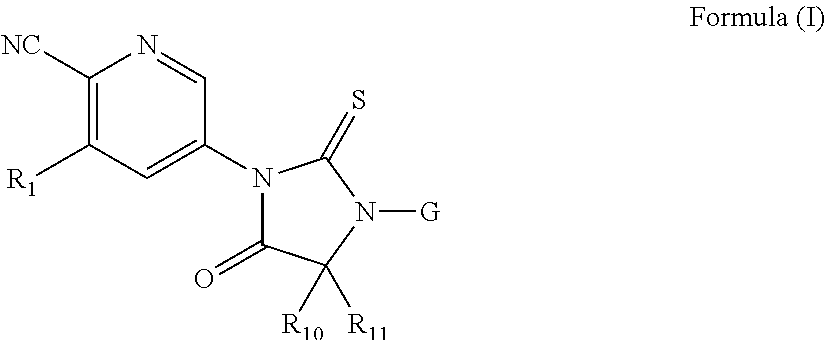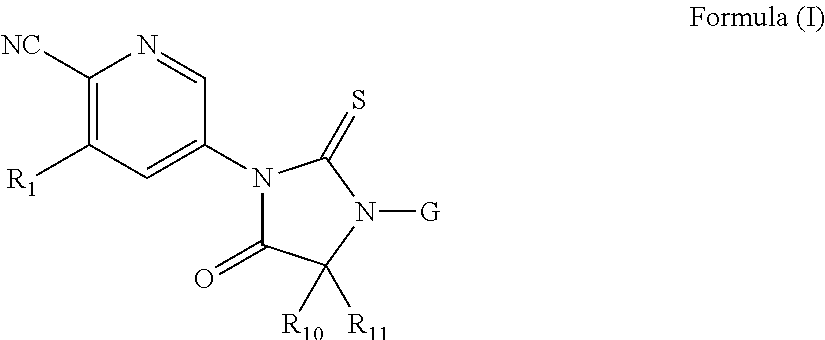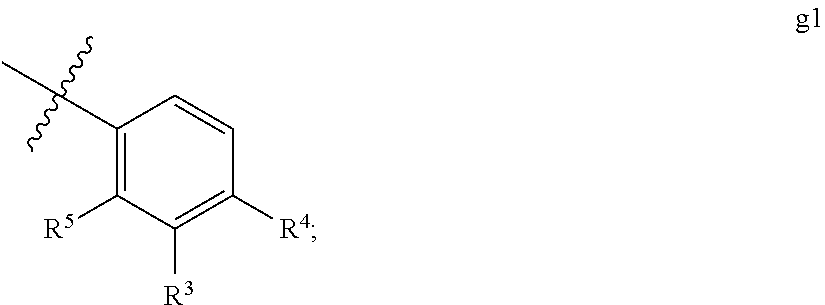Thiohydantoin androgen receptor antagonists for the treatment of cancer
a technology of thiohydantoin and hydantoin, which is applied in the direction of antineoplastic agents, organic active ingredients, drug compositions, etc., can solve the problem that the efficacy of even second-generation, highly potent ar antagonists, such as mdv-3100 (enzalutamide, xtandi®), is short-lived in many patients
- Summary
- Abstract
- Description
- Claims
- Application Information
AI Technical Summary
Benefits of technology
Problems solved by technology
Method used
Image
Examples
biological example 1
Radioligand Binding of Compounds to AR, GR and ER
[0325]Radioligand binding assays are performed with the cell extracts and ligands as detailed below. Complete methodology is contained within the cited publications. Kd values are determined by Non-Specific Incubation Detection Method.
[0326]Receptors
GR (human) (agonist radioligand) IM-9 cells (cytosol)
[3H]dexamethasone 1.5 nM 1.5 nM triamcinolone (10 μM) 6 h 4° C. Scintillation counting (Clark, A. F et al. (1996) Invest. Ophtalmol. Vis. Sci., 37: 805-813).
ER (nonselective) (human) (agonist radioligand) MCF-7 cells (cytosol)
[3H]estradiol 0.4 nM 0.2 nM 17β-estradiol (6 μM) 20 h 4° C. Scintillation counting (Parker, G. J et al. (2000) J. Biomol. Screen., 5: 77-88).
AR (human) (agonist radioligand) LNCaP cells (cytosol)
[3H]methyltrienolone 1 nM 0.8 nM mibolerone (1 μM) 24 h 4° C. Scintillation counting. Zava, D. T et al. (1979) Endocrinology, 104: 1007-1012.
[0327]The results are expressed as a percent of control specific binding measured s...
biological example 2
[0353]LNCaP cells (8,000 / well) are plated in RPMI media containing 10% Charcoal Dextran Stripped Serum into plates coated with poly-d-lysine. After 24 h cells are treated with compound from 30 μM to 0.0003 μM. At 20 h post compound addition the cells were fixed (30% formaldehyde in PBS) for 20′. Cells are permeabilized in PBS 0.1% Triton (50 μL / well, three times for 5′ each) and blocked with LiCor blocking buffer (50 μL / well, 90′). The wells are then incubated overnight at 4° C. with the rabbit IgG androgen receptor antibody (AR-N20, Santa Cruz antibody) diluted 1:1000 in LiCor blocking buffer / 0.1% Tween-20. Wells are washed with 0.1% Tween-20 / PBS (50 μL / well, 5′ each) and then incubated in goat anti-rabbit IRDye™ 800 CW (1:1000) and DRAQ5 DNA dye (1:10,0000 for 5 mM stock) diluted in 0.2% Tween-20 / 0.01% SDS / LiCor blocking buffer in the dark (90′). Cells are washed (50 μL / well, 5′ each) in 0.1% Tween-20 / PBS. Wash buffer is removed and plates were read using t...
biological example 4
[0354]LNCaP cells are seeded on day 1 in plates and incubated overnight at 37° C. prior to addition of 20 μL pre-diluted compound or DMSO (basal, vehicle control). Plates are incubated at 37° C. for 1-2 h before addition of 20 μL of ligand solution (antagonist mode, high control) or CSS medium (agonist mode, unstimulated control) and incubation of the cells for + / −24 h.
Cells are fixed in 140 μL of 10% Formaldehyde (5% final) and plates incubated for 15-20 min at RT. 100 μL 100% ice cold Methanol (stored at −20° C.) is added to permeabilise the cells, antibody staining protocol initiated and plates prepared for imaging. Staining is performed using an indirect immunofluorescence assay: for AR, primary antibody is a specific mouse anti-AR antibody (ab49450, Abcam), followed by a secondary goat anti-mouse antibody, carrying an alexa 488 fluorophore; for PSA, primary antibody is a specific rabbit anti-PSA antibody (5365S, Cell Signaling Technology), followed by...
PUM
| Property | Measurement | Unit |
|---|---|---|
| resistance | aaaaa | aaaaa |
| Clinical resistance | aaaaa | aaaaa |
| PSA | aaaaa | aaaaa |
Abstract
Description
Claims
Application Information
 Login to View More
Login to View More - R&D
- Intellectual Property
- Life Sciences
- Materials
- Tech Scout
- Unparalleled Data Quality
- Higher Quality Content
- 60% Fewer Hallucinations
Browse by: Latest US Patents, China's latest patents, Technical Efficacy Thesaurus, Application Domain, Technology Topic, Popular Technical Reports.
© 2025 PatSnap. All rights reserved.Legal|Privacy policy|Modern Slavery Act Transparency Statement|Sitemap|About US| Contact US: help@patsnap.com



